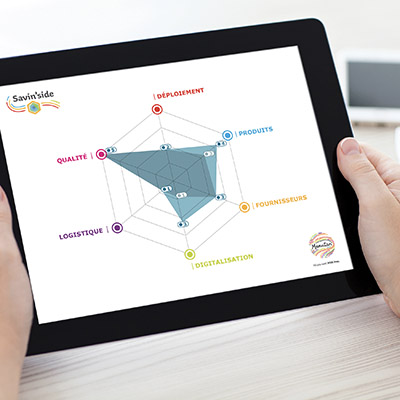As the environment around us becomes more and more complex and uncertain, logistics and transport represent a major challenge in all respects. For a company, an efficient supply chain is synonymous with competitiveness, standing out from the competition and customer satisfaction. After strictly regulating the procurement essential to their operation, namely head and mid-tail spend, organisations have every interest in properly managing the logistics of their long tail spend as well. You know, it’s that procurement category that includes most business transactions and deliveries. Previously considered, wrongly, as non-strategic, this procurement can become tremendous levers for improving operational performance, as well as financial, social, and environmental performance throughout the supply chain.
The logistical issues of long tail spend
By definition, long tail spend represents only a tiny percentage of the expenditure within companies but gathers on average 50% of procurement segments and 70% of the hidden costs of procurement departments. This category often suffers from unstructured management and escapes the control of procurement departments.
This leads to various interrelated issues inside the supply chains:
- Multiple suppliers;
- Single-line orders;
- A large volume of transactions and deliveries;
- Strong environmental and social impact.
These characteristics, which are specific to this category of procurements, make the logistics processes, especially the receipt of goods much more complicated in companies. Therefore, bringing long tail spend under control appears to be a key lever for optimising inventory management in the supply chains, while improving overall performance.
Two essentials for logistics management
For their procurement and supply process, companies must rely on distributors who demonstrate certain standards. Beside the traditional criteria for delivery times or warranty policies, for instance, they must ensure that their partners fulfil all the major challenges of the supply chain, with a combination of sustainability and efficiency.
A sustainable supply chain
To transition to a supply chain that is kind to both the environment and people, distributors and their suppliers must adopt several best practices.
Educate internal customers
You need to ensure those ordering and/or using the product have enough information to help guide them with their choice of products and to encourage them to place mass orders:
- Fully detailed product descriptions;
- Emphasis on the eco-friendly offer;
- Automated suggestion of complementary products;
- Minimum order requirement set up on the e-procurement tool.
Redesign the packaging
When reducing unnecessary and/or difficult-to-recycle waste, you must also reconsider your packaging choices, whose environmental impact is disproportionate to how we use it currently. For this, you need to prioritise two main principles in the warehouse:
- Reduce empty space transport by changing the packaging to fit the size of the goods and by reducing over-packaging;
- Consider the packaging composition and favour recycled, reusable materials, etc.
Optimise transport
Goods transport is responsible for most greenhouse gas emissions in the logistics department. This is why each link in the chain must:
- Streamline deliveries as much as possible;
- Optimise both truck loading and delivery rounds;
- Use low-emission vehicles.
An efficient supply chain
With the growing complexity of the supply chain in the industry, securing goods and improving efficiency has become a priority.
Rely on robust networks
In order to overcome the challenge of securing supplies, distributors must combine:
- A solid network of historical partners (suppliers and carriers);
- A geographical location that suits customer needs.
Get equipped with advanced technologies
For efficient, fast, and reliable processes, several technological tools have become essential for supply chains management:
- Electronic Data Interchange (EDI);
- The App Programming Interface (API);
- Robotics (autonomous mobile robots, automated storage systems, robotic arms, etc.).
Offer value-added services
There is a value-added service to suit each need to help companies gain time, agility, and performance:
- Custom deliveries (by appointment, on a fixed day, etc.);
- Installation/assembly of furniture;
- Industrial vending machines available 365/7/24[1];
- Take-back and upgrading of end-of-life products.
Optimisation of the supply chain in "project" mode
In addition to these basic principles that distributors need to consider in their overall service, procurement departments can also implement a special strategy in "project" mode to optimise inventory management in the supply chain.
One of the major challenges in terms of long tail spend remains the rationalisation of flows within the supply chain. Changing to mass orders and mass deliveries reduces both administrative cost and environmental impact, while reducing operators' workloads.
Three main optimisation levers can be used to help with this:
- Supplier rationalisation, which means replacing certain suppliers with a benchmark distributor;
- Digitalising transactions by rolling out an e-procurement solution, as well as potentially introducing a feature requiring a minimum number of orders;
- Contract deployment, which ensures that internal customers adhere to the framework agreements implemented to eradicate "maverick" spend.
Optimising your logistics chain means you have to develop a network of good partners who are organised and efficient so that they can cope with the current challenges posed by the supply chain. They must also have the required resources to support the companies with the management of their long tail spend optimisation projects. There is a method that relies on data analysis, a Lean approach and an agile framework to identify 6 key levers showing how mature companies are with their long tail spend management. It is through using this strategy that companies can increase their overall performance and gain in competitiveness.
- Download our white paper on “Long tail spend: 6 levers to optimise your strategy”.
[1] 365 days a year, 7 days a week, 24 hours a day









